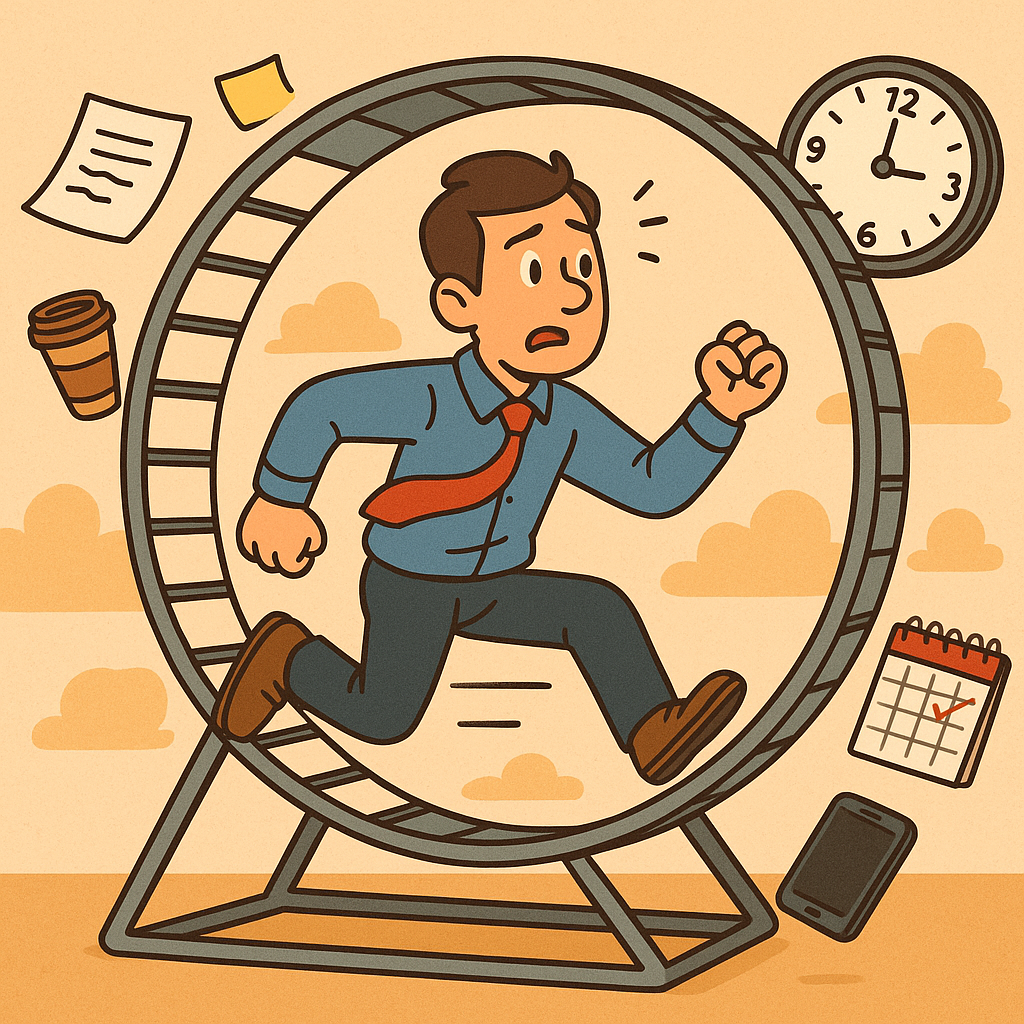It’s easy to slip into a routine where you’re constantly busy—but end the day feeling stalled. At that point we say you are busy but not moving forward. This guide helps you identify those signs of false progress and reclaim time for real impact.

1. The Busy Trap: Why “Doing” Isn’t Always Progress
“Busy” has become a modern badge of honor, but research shows this can be misleading. Multitasking and reactive workflows may feel productive, but often derail real progress. For instance, University of Michigan cognitive scientists found that switching tasks mid-work increases completion time by around 25%. Meanwhile, Microsoft employees took nearly 15 minutes to regain focus after an interruption.
The result? You might clock long hours but feel like you’re locked in place—a classic case of being busy but not moving forward.
2. Hot Trend: “Task Masking” & Productivity Theater
A new trend especially visible in Gen Z workplaces is task masking: appearing active—like scheduling fake meetings or sending nonstop emails—without doing meaningful work. Experts say this isn’t about slacking—it’s often anxiety-driven or a response to unclear expectations. The term “productivity theater” extends this idea: it’s all about looking busy, not being effective.
If you’ve found yourself nodding along at meetings but haven’t made real headway, you’re likely caught up in this trend—another sign of being busy but not moving forward.
3. Signs You’re Busy Without Progress
Here are telltale signals you’re merely spinning your wheels:
- No Clear Outcomes
You handle tasks, but nothing aligns with your bigger goals. - Always Reacting
Your day is inbox- or meeting-driven, not planned. - Low Focus Blocks
Long stretches are spent on shallow work like emails. - Lack of Brain Time
You never get uninterrupted time for planning or ideating. - End-of-Day Doubt
You close your laptop exhausted—but unsure of your accomplishments.
These symptoms often stem from a focus on movement—not growth.
4. Why Progress Beckons Beyond Busy
The allure of busyness is understandable: it feels productive and can even build status. Yet its drawbacks are severe. The American Psychological Association links chronic busyness to stress, burnout, disrupted sleep, and reduced satisfaction .
Effectiveness, however, fosters better outcomes: when focused on meaningful work, individuals report higher self-esteem, well-being, and even physical health .
5. A Smart Framework to Break Free
Use this four-step plan to escape the busy-but-static cycle:
5.1 Map Your Time (The Calendar Audit)
Color-code a week’s calendar into:
- Meetings/emails (reactive tasks)
- Deep-focus work (creative tasks)
- Learning or inspiration time
- Reflection / strategic thinking
If reactive tasks dominate, it’s time to rebalance.
5.2 Timebox Deep Work
Schedule protected blocks for your high-impact work. Minimize interruptions—turn off notifications and explicitly communicate your “focus mode.”
5.3 Embrace “Justified effort”
Adopt the Gen Z mindset identified by Oxford researchers: doing less—but for worthwhile goals—is not laziness; it’s smart prioritization.
5.4 Check Outcomes, Not Activity
Adopt an outcomes-oriented mindset:
- At the start of the day, define 1–3 impact goals aligned with your larger vision.
- At the day’s end, assess if you moved those needle metrics.
Reacting to emails counts less than delivering against those agreed priorities.
6. Daily Habits That Propel Real Momentum
| Habit | Purpose | Impact |
|---|---|---|
| Weekly Outlook | Plan 2–3 value-driven tasks | Reduces reactive surplus and focuses effort |
| Pomodoro Sessions | Intense 25-min focus periods | Improves concentration and combats shallow working habits |
| Single-tasking | One project at a time | By avoiding multitasking, you reduce errors and depth loss |
| Reflection Breaks | Weekly retros to refresh priorities | Helps renew purpose and eliminate busyness |
—
7. Real-Life Progress Stories
- Google’s “20% Time”: Developers could spend 20 % of their schedule on exploration—leading to Gmail and AdSense. This created real innovation space beyond everyday busyness.
- Microsoft’s Multitask Findings: After tracking interruptions, they reframed calendars to carve out deep-thinking blocks—and saw increased innovation among staff .
8. Final Take: Move From Hurry to Headway
If your daily actions don’t align with your larger goals, you’re likely caught in a busy but not moving forward trap. By measuring outcomes, blocking out focused time, and embracing purposeful effort, you can pivot from motion to momentum.
Next Steps
- Try the calendar audit this week
- Choose one impact goal for each day
- Set one deep-focus block, no distractions
- Reflect weekly: are you moving forward—or just busy?
By combining thoughtful planning with intentional action, you reclaim your time and steer forward—rather than spinning in place.
References
Spencer, J. (2018). The Difference Between Busy and Productive. Medium. Retrieved from medium.com
“The Busyness Trap: Why Being Busy Doesn’t Equal Productivity.” (2023). Medium. Retrieved from https://hnambiar200.medium.com
Cohen, J. (2018, June 25). Busy vs. Productive: Which One Are You? Forbes. Retrieved from www.forbes.com






